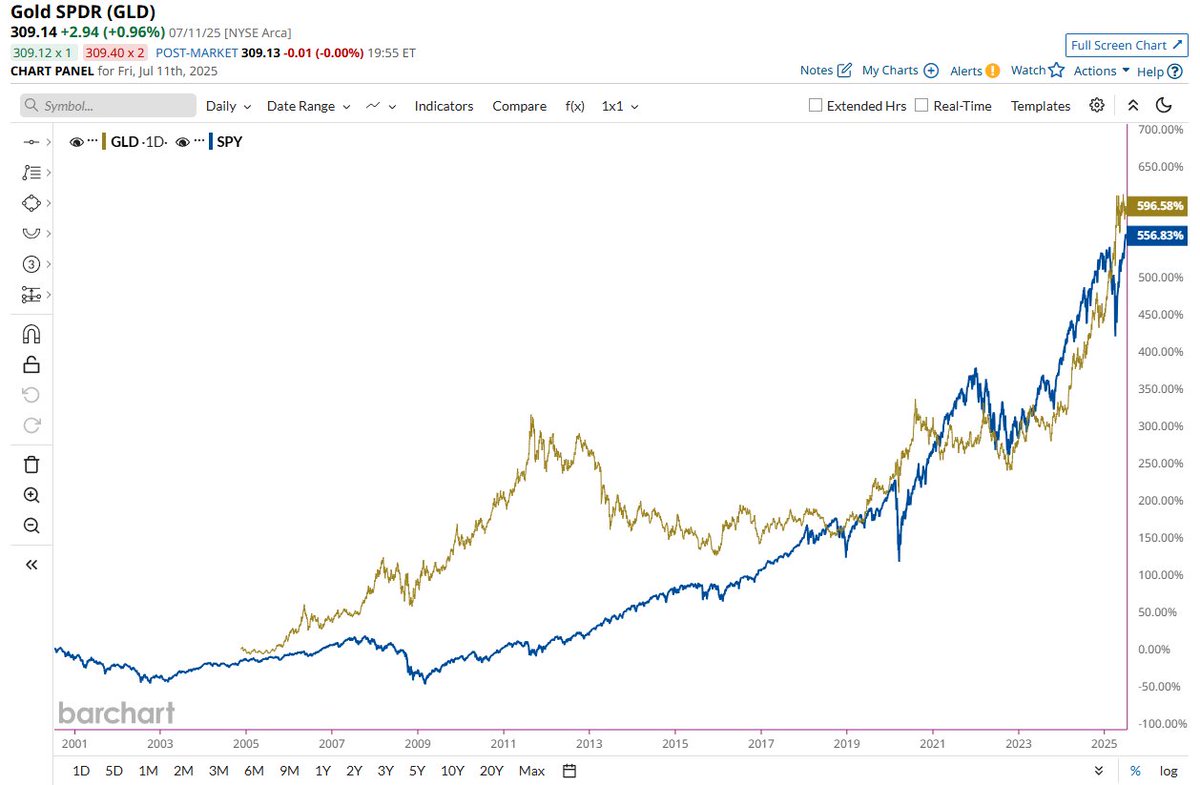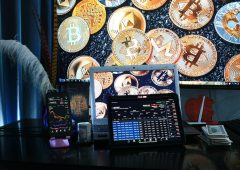Gold Beats U.S. Stock Market Over 25 Years, Even With Dividends Included
13.07.2025 15:00 1 min. read Kosta Gushterov
In a surprising long-term performance shift, gold has officially outpaced the U.S. stock market over the past 25 years—dividends included.
According to data shared by Barchart, SPDR Gold Shares (GLD) has delivered a cumulative return of approximately 596.58%, surpassing the 556.83% gain posted by the S&P 500 ETF (SPY) over the same period.
The chart tracks data from 2000 to July 2025 and accounts for total returns, making gold’s outperformance particularly notable given the common belief that equities, with reinvested dividends, consistently outperform commodities over long periods.
Several factors have contributed to gold’s impressive multi-decade run. These include the 2008 financial crisis, a decade of low interest rates and quantitative easing, pandemic-era stimulus measures, and persistent inflationary pressures.

Gold has historically been seen as a hedge against currency debasement and systemic risk—conditions that have repeatedly surfaced since the early 2000s.
Meanwhile, the S&P 500 has delivered strong gains driven by technological innovation and corporate earnings, but also experienced sharp corrections during the Dot-com bust, Global Financial Crisis, and COVID crash.
Its recovery from these drawdowns, however, has not been enough to consistently outperform gold over this particular time horizon.
With rising global debt, inflation volatility, and renewed geopolitical risks, gold’s role as a strategic long-term asset appears to be regaining prominence among both institutional and retail investors.
-
1
Russia’s Oil Revenues Strained as Exports Decline Again
24.06.2025 18:00 2 min. read -
2
Recession Fears Linger as Economic Signal Flashes Long-Term Warning
25.06.2025 9:00 2 min. read -
3
Gold Beats U.S. Stock Market Over 25 Years, Even With Dividends Included
13.07.2025 15:00 1 min. read -
4
Robert Kiyosaki Predicts When The Price of Silver Will Explode
28.06.2025 16:30 2 min. read -
5
Trump Targets Powell as Fed Holds Rates: Who Could Replace Him?
27.06.2025 9:00 2 min. read
U.S. Announces Sweeping New Tariffs on 30+ Countries
The United States has rolled out a broad set of new import tariffs this week, targeting over 30 countries and economic blocs in a sharp escalation of its trade protection measures, according to list from WatcherGuru.
Key U.S. Economic Events to Watch Next Week
After a week of record-setting gains in U.S. markets, investors are shifting focus to a quieter yet crucial stretch of macroeconomic developments.
Robert Kiyosaki Predicts When The Price of Silver Will Explode
Robert Kiyosaki, author of Rich Dad Poor Dad, has issued a bold prediction on silver, calling it the “best asymmetric buy” currently available.
U.S. PCE Inflation Rises for First Time Since February, Fed Rate Cut Likely Delayed
Fresh data on Personal Consumption Expenditures (PCE) — the Federal Reserve’s preferred inflation gauge — shows inflation ticked higher in May, potentially delaying the long-awaited Fed rate cut into September or later.
-
1
Russia’s Oil Revenues Strained as Exports Decline Again
24.06.2025 18:00 2 min. read -
2
Recession Fears Linger as Economic Signal Flashes Long-Term Warning
25.06.2025 9:00 2 min. read -
3
Gold Beats U.S. Stock Market Over 25 Years, Even With Dividends Included
13.07.2025 15:00 1 min. read -
4
Robert Kiyosaki Predicts When The Price of Silver Will Explode
28.06.2025 16:30 2 min. read -
5
Trump Targets Powell as Fed Holds Rates: Who Could Replace Him?
27.06.2025 9:00 2 min. read


